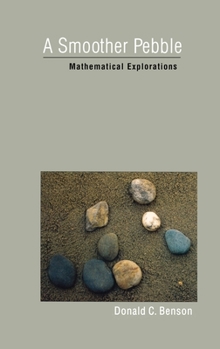A Smoother Pebble: Mathematical Explorations
This book takes a novel look at the topics of school mathematics--arithmetic, geometry, algebra, and calculus. In this stroll on the mathematical seashore we hope to find, quoting Newton, "...a smoother pebble or a prettier shell than ordinary..." This book assembles a collection of mathematical pebbles that are important as well as beautiful.
Format:Hardcover
Language:English
ISBN:0195144368
ISBN13:9780195144369
Release Date:October 2003
Publisher:Oxford University Press
Length:280 Pages
Weight:1.10 lbs.
Dimensions:0.9" x 6.3" x 9.7"
Related Subjects
Humanities Language Arts Linguistics Math Mathematics Science & Math Words, Language & GrammarCustomer Reviews
3 ratings
Some thoughts and perspectives on mathematical topics that are often overlooked
Published by Thriftbooks.com User , 16 years ago
The title has a double meaning, the first is from the quote of Isaac Newton, where he likens his scientific search to a child playing on the seashore and occasionally finding a smoother pebble. In the second case, since the word calculi means pebble or stone and from it are derived the words calculate and calculus, a smoother pebble can also mean an improved method of computation. Benson covers some of the major topics of mathematics from a historical perspective and relative to the modern approaches. He begins with the use of Egyptian fractions, detailing some of the advantages and disadvantages of performing computations with them. After this, there is an excursion into the great mathematical triumphs of the ancient Greeks, specifically, the development of the mathematical proof and the discovery of irrational numbers. In chapter 3, the topic is the mathematics of acoustics and the making of music, it is aptly titled "The Music of the Ratios." The next two-chapter section has the title, "The Shape of Things" and covers the geometry of surfaces, Euclidean and Non-Euclidean geometry and the development of the graph in coordinate geometry. I was particularly impressed by the descriptions of the development and use of the graph. Until I read that chapter, I had never seriously pondered the value of this incredible tool for simplifying the presentation of data. While a graph is never a formal proof, the insight that a graph can provide is often the initial impetus for a rigorous proof. The next section, called "The Great Art", is an explanation of the use of algebra, both classic and abstract. Working mathematicians have long past the day where algebra was a mystery to them and with familiarity comes a sense of mindless routine. A former student of mine once likened basic algebra to the act of going through a door. However, there is a great deal of fundamental mathematics being used when solving a simple algebraic expression and all mathematicians should stop on occasion and reflect on that fact. The final section, called "A Smoother Pebble" introduces calculus and some problems that it can be used to solve. The first chapter in this section is called "On the Shoulders of Giants" and is a brief historical survey of the historical development of differential and integral calculus. The second chapter in this section is a brief description of the mechanisms of differential and integral calculus. Only 24 pages in length, it unfortunately is just long enough to befuddle the beginner, as it is not long enough to provide enough information. The final chapter is "Roller-Coaster Science" and is a description of how calculus is used to calculate trajectories in curves, specifically for roller coasters. In general this book cannot be considered a member of the popular mathematics library, Benson uses many equations to make the mathematical points. However, it is a good review of some of the math people take for granted, as it contains some thoughts an
An Interesting Guide to the History of Mathematics
Published by Thriftbooks.com User , 21 years ago
This is definitely a very interesting book for anyone interested in Math. Most people, including myself, originally studied Math only to find out how to solve particular problems and never learned any of the interesting history associated with Math. A Smoother Pebble presents many interesting aspects of this history: for example, the horribly awkward use of Egyptian Unit Fractions and of Babylonian's Sexagesimal Number System. It also describes the mathematical ratios involved with the musical scales. I also found it interesting how the early use of graphs developed and the connection between Algebra and Geometry and the history involved in trying to find the path of fastest decent. I'm sure that a reader will also find other areas of particular interest.
A Smoother Pebble
Published by Thriftbooks.com User , 21 years ago
This was a very interesting book. I highly recommend this book for anyone interested in math.





